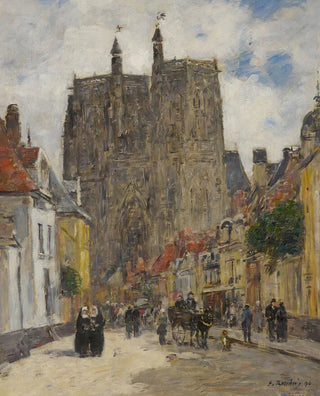Art print | Abbeville Street and Saint-Vulfran Church - Eugène Boudin


View from behind

Frame (optional)
Abbeville Street and Saint-Vulfran Church - Eugène Boudin – Captivating Introduction
At the heart of the artwork "Abbeville Street and Saint-Vulfran Church," Eugène Boudin invites us to immerse ourselves in a scene filled with light and life. This painting, a true reflection of the town of Abbeville, transcends mere landscape to become a window into a bygone era. The skillfully orchestrated composition by the artist transports us to cobbled streets, where shadows dance under the gentle Norman sun. The depiction of Saint-Vulfran Church, majestic and emblematic, stands as a focal point, captivating the eye and sparking curiosity. As you contemplate this piece, you can almost hear the murmurs of passersby and smell the fragrance of surrounding gardens, an invitation to explore the nuances of daily life in the 19th century.
Style and uniqueness of the artwork
Boudin, an undisputed master of light, manages to capture the very essence of his environment through delicate and expressive brushstrokes. In "Abbeville Street and Saint-Vulfran Church," he plays with contrasts between light and shadow, giving each element depth and texture that seem to vibrate with energy. The warm, golden tones enveloping the scene create a cozy atmosphere, while the meticulous details of facades and skies evoke a tangible reality. The fluidity of forms and the lightness of colors testify to an impressionist style that, while rooted in faithful representation, rises toward visual poetry. Each glance at this artwork reveals new subtleties—a dialogue between the painter and the viewer, a communion with the ephemeral beauty of the moment.
The artist and his influence
Eugène Boudin, often regarded as one of the precursors of Impressionism, knew how to leave his mark on his era with his innovative vision. Born in 1824 in Honfleur, he was deeply influenced by the changing light of the sea and Norman skies, elements that are central to his work. His passion for plein air painting and his desire to capture fleeting moments made him a pioneer in

Matte finish

View from behind

Frame (optional)
Abbeville Street and Saint-Vulfran Church - Eugène Boudin – Captivating Introduction
At the heart of the artwork "Abbeville Street and Saint-Vulfran Church," Eugène Boudin invites us to immerse ourselves in a scene filled with light and life. This painting, a true reflection of the town of Abbeville, transcends mere landscape to become a window into a bygone era. The skillfully orchestrated composition by the artist transports us to cobbled streets, where shadows dance under the gentle Norman sun. The depiction of Saint-Vulfran Church, majestic and emblematic, stands as a focal point, captivating the eye and sparking curiosity. As you contemplate this piece, you can almost hear the murmurs of passersby and smell the fragrance of surrounding gardens, an invitation to explore the nuances of daily life in the 19th century.
Style and uniqueness of the artwork
Boudin, an undisputed master of light, manages to capture the very essence of his environment through delicate and expressive brushstrokes. In "Abbeville Street and Saint-Vulfran Church," he plays with contrasts between light and shadow, giving each element depth and texture that seem to vibrate with energy. The warm, golden tones enveloping the scene create a cozy atmosphere, while the meticulous details of facades and skies evoke a tangible reality. The fluidity of forms and the lightness of colors testify to an impressionist style that, while rooted in faithful representation, rises toward visual poetry. Each glance at this artwork reveals new subtleties—a dialogue between the painter and the viewer, a communion with the ephemeral beauty of the moment.
The artist and his influence
Eugène Boudin, often regarded as one of the precursors of Impressionism, knew how to leave his mark on his era with his innovative vision. Born in 1824 in Honfleur, he was deeply influenced by the changing light of the sea and Norman skies, elements that are central to his work. His passion for plein air painting and his desire to capture fleeting moments made him a pioneer in






